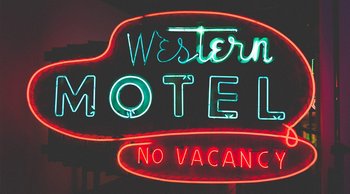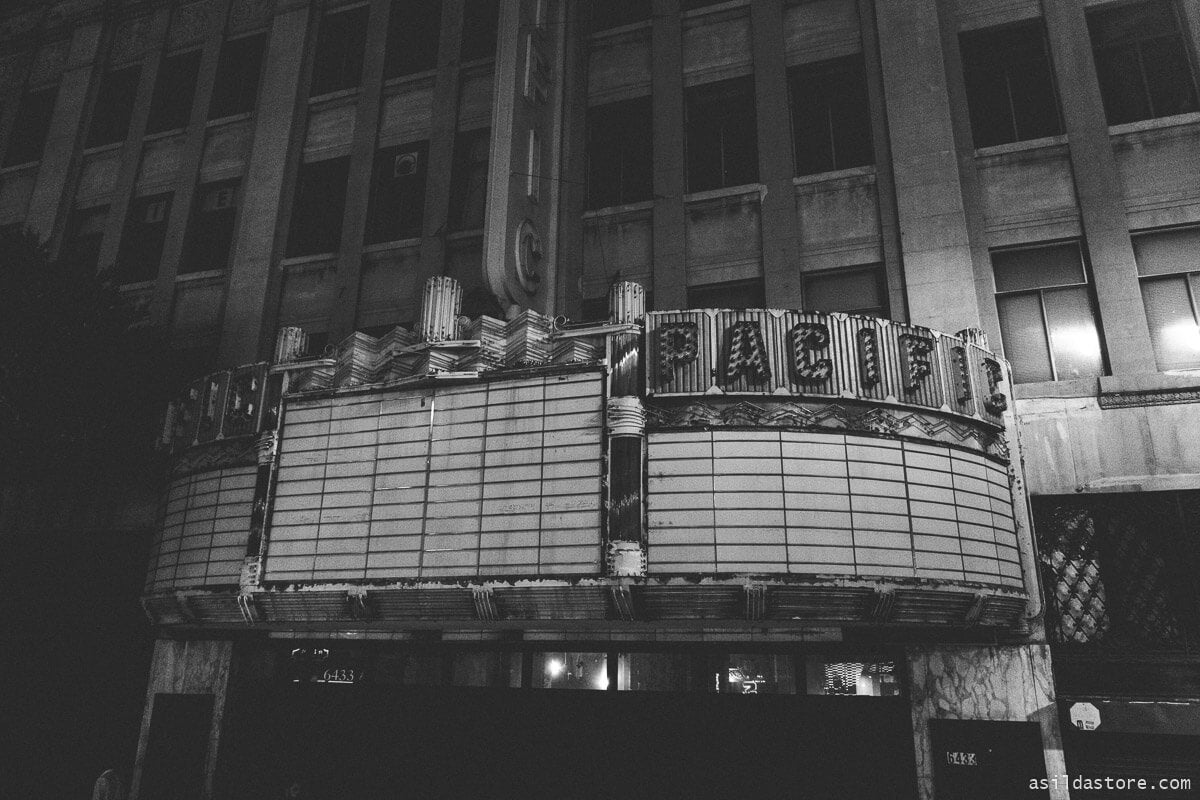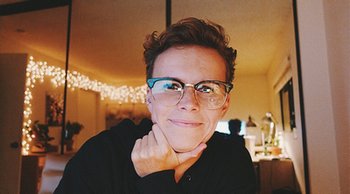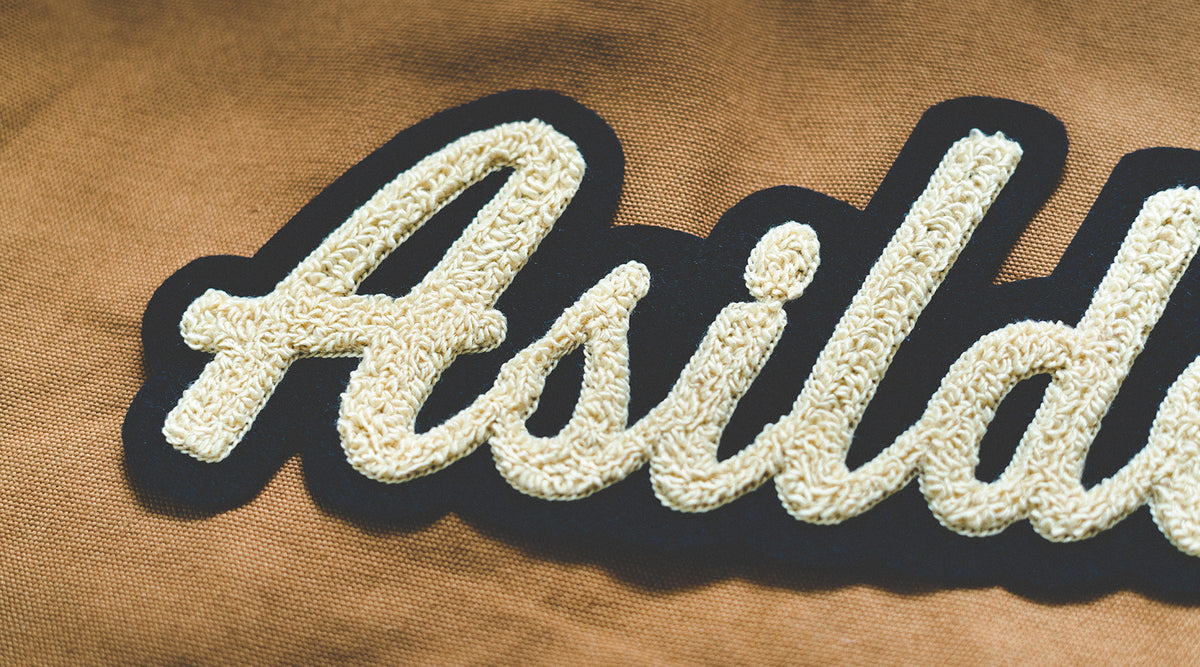Your Cart is Empty
Neon Signs: A Symbol of America

When you think Americana, neon is always a big part of the visual. Trendy restaurants and juice bars, pizza places and seemingly every cool business these days has a neon sign.
I can tell you that for me this neon addiction developed over many trips across America.
You arrive in a small town where everything is still from the 1940's and there is this giant fading metal sign with neon tubes looking into the sky, glorious and proud.





Neon signs are amazing to photograph, and it’s easy to do a good job with those photos. Neon, whether vintage signs or new ones, draws the eye and makes you forget about the present for a second. It’s almost like being in a movie for a minute.

Welcome to Fabulous Las Vegas Sign, June 1961. Source
We kept thinking all last year about a design we'd want to do for Asilda Store in the style of neon signs. Over time, my research got deeper and deeper.
With books about neon on my shelf and hundreds of photos captured on my trips, we thought we'd share my passion for neon and what we know about it now.
This is a good read, we promise. In short, here is what's coming:
- History of neon
- The commercial popularization of neon by Georges Claude
- 1920's - the peak of popularity
- Art meets science - how neons are made
- The last fading light - LEDs take over
- Neon Museums and places to visit
- Good info resources on neon
- List of neon artists and studios of today
- Neon signs for sale - Asilda goes neon!
- Final words
The History of Neon
Amazingly, despite needing electricity to work, the history of neon light actually stretches back to before electricity was even discovered. Back in 1675, a French astronomer named Jean Picard observed a faint glow inside a mercury barometer tube used to measure atmospheric pressure.
When the tube was shaken, he noticed a very faint light that he referred to as barometric light, although what was causing this glow (static electricity) wasn’t well understood at that time.
Nearly two centuries passed before the next chapter of neon lighting could be written. In 1855, Heinrich Geissler, a German physicist and glassblower began experimenting with applying an electrical current to various gases trapped in sealed glass tubes.
When a Geissler tube was placed under low pressure and an electrical voltage was applied, the gas would glow.

Sir William Ramsey, the Nobel prize winner who discovered neon. Source
The next step in the evolution of neon came in the 1890’s when the Scottish chemist, Sir William Ramsay, discovered four new elements. These were the “noble” gases neon, argon, xenon, and krypton.
The name noble came from the fact that these strange elements seemed completely unwilling to bond with other atoms as if other elements were unworthy of their presence. Neon took its name from Greek, meaning “the new one”.
Sir William Ramsey won the Nobel Prize for his discovery of noble gases. He discovered argon, helium, krypton, and then neon, in this order.
Despite being rare on earth, making up only 0.0018 percent of the atmosphere, neon is the fourth-most-abundant element in the universe.
It is forged inside the bellies of stars much larger and hotter than our own sun by the fusion of carbon under extreme pressures and temperatures. It is odorless and colorless - until a voltage is applied to it, often lots of voltage.
It wasn’t until the discovery of a way to isolate the noble gases that electrical discharge tubes such as the Geissler tube could reach their true potential as a source of light, rather than just a novelty.
In 1898, a method was discovered to separate neon gas from the atmosphere, and it was found that neon glowed a rich, dazzling orange/red color when an electrical current was passed through it in a sealed vacuum tube.
Sir William Ramsay found the glow emitted by neon to be so striking, he spoke of it in his 1904 Nobel Prize-winning speech for his work in discovering the noble gases. He described it as, “a brilliant flame-colored light, consisting of many red, orange, and yellow lines.”
His co-discoverer, Morris W. Travers, spoke of his own reaction to first seeing it, “The blaze of crimson light from the tube told its own story, and it was a sight to dwell upon and never to forget…. nothing in the world gave a glow such as we had seen.”
Soon, many more people were about to be given the opportunity to experience this strange new light source.
George Claude Bringing Neon to the People
The first person to demonstrate neon light in a commercial application was Georges Claude, a French engineer and inventor.
 George Claude. Image Source
George Claude. Image Source
After spending several years perfecting the needed manufacturing techniques to keep impurities out of the tubes to prevent them from flickering and to extend their useful life, he presented his neon tube lighting in its current form at the 1910 Paris Motor Show.
 Paris Motor Show 1910. Image Source
Paris Motor Show 1910. Image Source
People were dazzled by the unique color and brightness of the light. They were bright enough to be seen even in broad daylight. In 1912, he installed the world’s first neon advertising sign above a trendy Parisian barbershop located on the Boulevard Montmartre.
Other iconic early neon signs were installed for the Italian vermouth manufacturer, Cinzano and a neon-illuminated entrance for the Paris Opera.
In 1923, Georges Claude brought his neon lights to the American market.
When you search the web, the story often goes that the first neon signs in America were the two signs sold to a Packard car dealership in Los Angeles that each spelled out “Packard” in full neon glory. Recently, this information has been proven wrong by several members on the board of Museum of Neon Art in Los Angeles.
Most likely, the neon traveled from Europe to New York City, then to the West Coast.
Claude's company had the advantage of making huge amounts of neon as a by-product of his main business selling liquefied air, and by patenting the processes needed to make commercial neon signage, he initially had a monopoly on the whole neon sign market.
In 1924, Clause was selling about $240,000 worth of neon signs and in just a few short years grew the business to $20 million annually.
The investment for small and large businesses into neon signs seemed to pay off almost immediately as the signs were such a sensation that they caused traffic jams as people stopped to stare in wonder at their intense and unusual glow.

Camel Cigarettes Sign on Times Square had been puffing smoke every 4 seconds from 1941-1966. Source & Source
A Sign of the Times
Advertisers and the public completely embraced neon signage and soon the downtown areas of nearly every major city in the US were glowing in the neon light.
Neon signs were incredibly popular for the following years, becoming something of a cultural phenomenon in America, with places such as Times Square taking full advantage of their ability to dazzle and focus attention. Signs fueled by glowing neon became icons of commerce and entertainment.
The bright lights of neon came to signify the bright possibilities of the electronic age, a symbol of progress. There was nothing more modern than neon.
Despite New York and Las Vegas now being more synonymous with bright neon lighting, it was Los Angeles that became the real American home of neon in its earliest years.
In the 1920’s, Los Angeles was booming and modern businesses, especially those in the automobile, motel, diner, radio, and entertainment industries couldn’t get enough of the new type of lighting to advertise their presence.

Pioneer Club, Las Vegas, April 1969. Source
Colored Light
When an electric current passes through a neon gas in a tube, it gives off its distinctive orange/red color. But there are two methods that allow many other colors of light to also be created.
The first involves using different gases, each of which produces its own distinctive color.

Source: madebypi.co.uk
There is also another way to make a huge variety of colors using phosphor coatings on the inside of the light tubes. As mercury emits a spectrum rich in ultraviolet light, this excites the phosphor coating to glow.
And as phosphors are available in numerous colors, up to 250 different colors of “neon lighting” are possible.
The other great attribute of neon lights is that they require almost no maintenance, or so it seemed at first compared to the incandescent light bulb.
A well-made neon tube can run continuously for more than 20 years. What spells the end of the lights life is usually unrelated to the light itself, such as electrical faults from being out in the elements or breakage of the glass itself.
Art Meets Science
While the concept behind neon lighting - electrifying a gas trapped in a tube, is fairly straightforward, building the lights is a tricky and painstaking task. There is no hack to the process, it's a handmade job. Every single time.
The new neon sign makers have to carefully heat narrow glass tubes over an intense torch flame to create the desired bends and curves of the letters or shapes being created. They also have to frequently blow air through the heated tubes to prevent them from collapsing.

Once the glass tubes were formed to the desired shape, electrodes need to be attached to each end of the tube, the existing air evacuated, and high voltage electricity passed through the tube to clean the glass.
Small amounts of the preferred gas are then pumped into the tube, usually, some mixture of neon and argon, sometimes with small amounts of mercury added. The finished tubes are then mounted onto a supporting plate and the electrical switches and wiring mounted behind the plate to control the lights.
The whole process is intricate because the glass is very brittle and breakages are common.
As a result, neon sign making became a true art form, especially when you consider the complexity of animated neon signs where multiple layers of tubing are required and the speed of the animation is controlled by the distance between the magnets.
Here is the best video I could find on the art of neon sign making.
These impressive artworks that gave the appearance of motion and were the ultimate level of complexity and craftsmanship.
The new neon signs were soon showing off huge flashing cocktail glasses above nightclubs, cowboys waving you into the gambling clubs, divers jumping into pools to showcase luxury accommodations, and numerous other variations of movement and glow.
By combining hundreds of different neon tubes, miles and miles of electrical cabling and thousands of switches, there was really no limit to what could be created in this new integration of art and science.
The Last Fading Light
With the threats of WWII, blackouts were ordered in all major cities and neon signs that so vividly turned everything alive were shut down, often for good. After the war was over, many businesses decided to install new signs instead of repairing a now old technology of neon.
Neon was no longer trendy and new. It was weathered, rusting, breaking, expensive to maintain, and for the new consumer generation that loved everything disposable, neon was no longer attractive.



Despite neons being of great value at the time, soon light emitting diodes (LEDs) took over as the preferred electronic display lights.
Lower maintenance signs that used cheaper plastics and fluorescent tubes slowly took over as the preferred advertising signage. Despite not being as visually impressive, the lower cost fluorescent tubes pushed neon signage to more of a niche aesthetic.
Neon is always seen as more lively, warm, maybe even eternal. LEDs are bright, detailed, and cold. It's an aesthetic and economical choice for most businesses.
Neon as an art is still struggling to find its proper place, but many artists and enthusiasts continue to carve out this niche and showcase the neon creations in all their complexity and glory.

TV screens and enormous billboards also pushed neon further out of the advertising and signage space. Some came to see old neon signs as being an outdated or unwanted technology, more closely associated with seedy bars or decaying casinos.
Nevertheless, neon continues to hold a firm place at the heart of Americana culture.
Despite a slow decline in use over the decades, neon is still used in signage today, due to the unique elegance emitted by its light that is hard to replicate by other means. Soul Cycle, WeWork, local breweries, barber shops, juice bars, eateries, and other businesses choose to display neon signs.

Places to Visit
The past year of exploration of neon got us into some amazing places, several of which we visited numerous times by now. If you feel like getting more serious about neon exploration, here is a list of places to add to your trips:
- The Neon Museum in Las Vegas, NV
- Museum of Neon Art (MONA) in Los Angeles, CA
- American Sign Museum in Cincinnati, OH
- Henry Ford Museum in Dearborn, MI
- Freemont Street Experience in Las Vegas, NV
For those interested in finding out more about the history of neon and the role it played in the history of the city of Las Vegas, there is a great collection of classic neon signs at The Neon Museum, which opened in downtown Las Vegas in 1996. The city signed a 50-year lease for the land and rents it out to the museum for $1 per year.
Many of the signs in the collection were donated by YESCO, a famous sign company responsible for dozens of legendary neon signs in Las Vegas and beyond. YESCO stored the signs they were taking down and ended up donating many of them to the Neon Museum.
Side note: YESCO currently owns the "Welcome To Fabulous Las Vegas" neon sign and created and installed the famous Vegas Vic sign, in addition to creating the Freemont Street Experience that's a pretty amazing thing to see.
We were at the Neon Museum in Las Vegas a few weeks ago during the evening installation called "Brilliant." It was a pretty amazing 30-minute show that provided the perfect ending to the day.
Out of numerous signs the museum owns, only 11 are restored and are working. You walk around faded, damaged, incredibly beautiful pieces of art that will most likely never emit neon light again.


There is also a great museum dedicated to the artistic use of neon, the Museum of Neon Art in Los Angeles. It includes both electric and kinetic fine art as well as a range of examples of famous or historic neon signs. We visited "She Bends" and “Motel California” and both were amazing expos.
Here are some photos from our last visits to MONA.












They also have bus tours called "Neon Cruises" around Los Angeles taking you on a bus to the most iconic neon signs still remaining in LA. We did the first bus tour of 2018 recently and even though there are considerably fewer neon signs around, the tour was pretty amazing and we got to cruise the city on the second floor of the bus.


The best thing about it was that we didn't have to look at all the clutter of pedestrians walking and front doors of places. We were elevated to see the older wall signs, beautifully cracking paint on the old buildings, and neon signs on our eye level, which you can only experience at the neon museums (normally we always have to look up).
Here are a few photo highlights from this 3-hour ride.



Next time you visit Los Angeles, New York City, Las Vegas, Vancouver, Tulsa, Chicago, Nashville, Miami, or any city really, take a look around. Neon hunting is a pretty fun activity as you roam and explore new cities.
Good Info Resources on Neon
After spending hours on Amazon and in bookstores, we finally have a solid grasp on where to find quality info on neon. Here are some recommendations and where to purchase these movies and books.
We'll start with a movie that came out in 2016 called "Neon." It's a beautiful and a quite detailed look at the history and spirit of neon. Watch the movie on Amazon (watch it free if you have Prime) or rent it on YouTube:
Quality books on neon:
- Neon Nevada ~$5 - small, but an interesting book with great photos of Nevada neon signs
- Vintage Neon ~$20 - a great collection of neon signs and stories behind them. You'll pick up on themes and some very unique facts not mentioned in other books. It's 195 pages and will take you a week or so to fully take it all it.
- Signs, Streets, and Storefronts: A History of Architecture and Graphics along America's Commercial Corridors ~$35 - this one is more of a textbook and not just on neon signs. It's a great comprehensive look at the history of signage.
- Spectacular Illumination: Neon Los Angeles, 1925-1965 ~$35 - the only/best way to see what LA neon streets looked like, because today almost nothing remains
- New York Neon ~$20 - a very solid introduction to neon with sketches and historic photos not found in other neon books, followed by a collection of NYC neons signs photographed by the author
- Flickering Light ~$8 - don't wast your time and money on this one. It's got very basic facts and half of it is more about poetry and movies than about neon history.
- The Motel in America (The Road and American Culture) ~$3 - a fabulous book that dives deep into the reasons motels came to be, how and why the boom happened, architecture influences, and much more. It's very interesting to read, is full of stats, yet it not a daunting textbook.
Neon Artists of Today
From 5,000+ neon artists in George Claude days, we are now down to hundreds. Neon schools that used to be everywhere after WWII are no longer in existence. Art schools teach glass bending classes and some neon classes, but we are no longer at the scale of education that was available 30-50 years ago.
There seems to be a very distinctive line between commercial neon sign makers and neon artists. You either "manufacture" something or you "create" it. There is not a big overlap among neon benders who do both.
Stay tuned for a separate post with the list of neon studios and neon artists of today. The list is being compiled as we type and you'll have a comprehensive resource with all the info we love to see: IG links to artists, websites, locations, names, and commentary on what they create.
Want to Learn How to Bend Neon?
Here are a few helpful resources we collected over the last few times. If you know of any other classes and workshops, drop a comment at the end of the post. We'd really appreciate it.
- MONA Neon Immersive Course and One-Day Workshops
- Just Neon Workshops
- Crucible Workshops
- Lili Lakich Neon Workshops
- Brooklyn Glass Workshops
- Peterson Neon Workshops
- Krypton Neon Classes
- Meryl Pataky Workshops
- Urban Glass
There are 3 typical setups for neon classes: one day, full weekend, multi-week evening classes. The costs, for the most part, are pretty consistent: $300-600 for shorter classes and $1,500+ for multi-week courses.
If you think about it, there are not many artists lest who are teaching glass bending and neon art. So you're definitely going to learn a new skill, have fun doing it, and learn from the very few remaining masters of our time.
Neon Across America
After two trips on Route 66 (read more about the best Western Stops on Route 66), we always think that there is no better reminder of our changing world than tall structures of signs in towns large and small all over America.
You drive through a small town and there it is. An old abandoned motel with the signs still up, the metal is probably sunburned, and there is nobody around for miles. I tried to find a list of the most famous neon signs across the US, and there is a pretty good compilation on recapturist.com.
Our own travels took me to places where I could hunt for neon signs.
Always charmed by their appearance, the craftsmanship of the sign design and build quality, we see in neon signs something that is rarely put front and center anymore - an object that's made to last decades.
If you want to contribute to the preservation of neon signs, donate to the museums in LA and Las Vegas and try to stay in old motels that are trying to stay alive and still maintain their neon signs.
Neon Signs for Sale
There are not many places where you can buy neon signs for your house or apartment. If you think about the cost, it’s about the same as for a nice piece of art of a large framed photo. You can expect to spend anywhere from $170 to $600 for a small to medium neon sign.
Most signs are made to order. The ones you can find in stock on eBay are the cheap Chinese slim tubed signs that don’t do neon justice. There are only a few legit stores that make quality stuff, and the selection is often very limited.
Look through the list of neon artists and our helpful guide on neon signs for sale: where to buy neon art today (coming to the blog in 2 weeks).
Conclusion
With this post, our neon adventures are not over and you'll be sure to see more neon-themed posts on this blog. We hope you liked diving into the history of neon and share our passion for analog art and craftsmanship that machines cannot replicate.
Also in Asilda Blog

Why I started Vlogging - My 3 Reasons
The first month of vlogging is done and now I get asked more and more about why I started all this, and especially right now. So here are my three reasons.
Read More
Cecilia Humboldt Camera Backpack Review
Join me in reviewing this Cecilia Humboldt 14L in Black Leather Camera Backpack I got to test out. The leather is buttery smooth and the bag is very enjoyable to use.
Read More
Custom Chenille Jacket Patches
In America, most people probably know chenille best for its use to make the furry patches emblazoned on high school letterman jackets...
Read More
